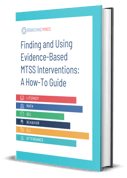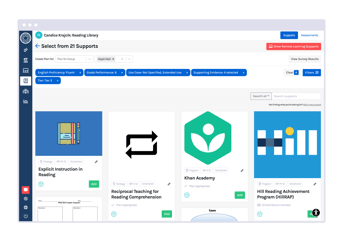Accelerated learning is currently one of the hottest keywords in education. It is hailed as the hero to address “learning loss” and large instructional gaps. Some states have even gone as far as adopting it into their educational policies, hoping to help students catch up to grade-level benchmarks.
“Learning loss” implies that students have missed out on learning. As educators, we know that learning is occurring but not at the traditional levels. So, the phenomenon that many educators face is really about “instructional loss” and not necessarily about placing the blame on the students.
The solution? Accelerated learning.
For those new to the term, accelerated learning is the adaptation of instruction in which curriculum standards are prioritized based on the learning needs of students. It is an intentional, practical approach to intensive instruction to address a significant gap in skills resulting from a disruption to instruction.
What is important to note is that acceleration is not remediation. It is not going back and attempting to fill in every student's gap in knowledge in a content area. Instead, acceleration focuses on what skills are most important for a student to master the content and scaffold those skills using interventions and learning supports in coordination with the grade-level curriculum.
Learning supports and interventions play a crucial role in successfully implementing an accelerated approach. Based upon universal screening data, learning supports provide scaffolding at the core level to address the most common skill gaps in a classroom.
Research-based interventions provide more targeted and intensive support for students who need extra help mastering grade-level content. Without the combination of data and intervention resources, it’s impossible to deliver differentiated instruction for all student's readiness levels, interests, strengths, and learning preferences required to build up necessary skill sets.
➡️ Related Resource: A Quick Review of MTSS Supports, Interventions, and Accommodations
That’s all fine and dandy, but it doesn’t address the actual “how-to” when selecting these supports and interventions. Let’s take a moment to analyze three considerations when choosing appropriate supports for accelerated learning:
Consideration #1: Learning Supports and Interventions Should Be Targeted, Research-Based, and Chosen Based on Alignment With Core Instruction
When selecting a learning support or intervention in correlation with an accelerated core instruction, it’s imperative to select specific, research-based resources with a clear framework for implementation and progress monitoring.
Without universal screening data, educators will go in blind when attempting to structure their accelerated instruction. They will not clearly understand which skills require scaffolding at the class level and which students require additional support.
After analyzing screener data, learning supports and interventions should be chosen based on alignment with core instruction and provide scaffolding for the data-identified skills. These supports should be considered as additions to a strong core curriculum; they do not replace it entirely. With this in mind, it’s essential to clearly understand what areas the core curriculum will focus on before selecting learning supports and interventions.
While both of these resources provide additional support, interventions are more targeted and specific than learning supports. While a learning support may be used at the whole class level, interventions are specific for individuals or students in small groups. For example, if a student requires reading support, an intervention needs to address one or two skills within that content area. Interventions are not simply “reading” interventions. For example, an intervention would focus on morphology rather than reading as a whole. Interventions should also be coupled with an intervention plan which accounts for scheduled progress monitoring. We will discuss this more in the next section.
➡️ Check out this MTSS Intervention Process Flowchart Guide
When selecting either learning supports or interventions, educators should ensure that each support they implement is research-based and targeted. The Every Students Succeeds Act (ESSA) outlines clear guidelines on evaluating educational resources based on their research and evidence validity. The Branching Minds library labels each of our resources based on its ESSA level. Educators can also access research databases, such as Intervention Central, to review guidelines of ESSA and examples of interventions.
Consideration #2: Interventions Should Be Used in Conjunction With SMART Goals and Progress Monitoring in an Accelerated Learning Framework
As discussed above, interventions should be targeted to a specific skill and research-based. An intervention should also be implemented in coordination with a SMART goal and a clear intervention plan. While this is true for any instructional model involving interventions, it’s vital in conjunction with an accelerated learning model.
➡️ Related Resource: Aligning SMART Goals to the Just-Right MTSS Interventions
Due to the nature of accelerated learning, where educators are attempting to adapt to interruptions in instruction, universal screeners may not adequately assess all the learning gaps a student may be experiencing. Universal screener data should be used to create goals and focus intervention plans. Then, once these goals and plans have been implemented, educators will need to utilize progress monitors throughout the plans to assess progress.
Progress monitoring allows educators to evaluate whether an intervention is being implemented with fidelity and whether the student is progressing toward their goal. With a core instruction that is already supercharged to move faster than years in the past, it’s imperative that educators consistently track the progress and efficacy of interventions.
If progress monitoring shows that a student is not progressing, the intervention plan should be reevaluated. If the student is making only slow progress, then the student may need to receive more intervention time. If the student is making no progress, then the chosen intervention should be reconsidered as it may not be targeting the just-right skill. This can often be the case if a student has a significant skills deficit, and the universal screener data only identifies a few.
One of the first steps in accelerated learning is to prioritize which standards are the most important for students to master content. When considering these standards, it’s helpful to go back and create a list of all skills required to master this standard. For example, when evaluating a student’s intervention plan, this list can be used as a reference to breaking down a student’s gap in skills in a concise and structured way. Think of this list like a staircase that leads the student to the grade-level skill. If a student skips a step, then they won’t be able to climb to the top.
Consideration #3: Utilize SEL Learning Supports and Interventions to Provide Additional Support
Learning supports and interventions are also valuable tools to utilize when accounting for Social-Emotional Learning (SEL). As mentioned, an accelerated core framework is typically implemented in response to an event that has interrupted traditional learning. In the current world of education, that event was a global pandemic.
Students who have experienced an interruption to learning will often require additional support beyond the supports given within their core instruction. These supports can help students cope with a traumatic event's emotional and mental implications, such as the pandemic.
Historically, when considering an accelerated instructional model, the emphasis was often placed on only tested content areas. Educators risk jeopardizing their instructional impact by disregarding students’ social and emotional needs. For example, a poor test score may be linked to mental health needs just as much as it could be linked to a content area need. SEL learning supports and interventions can help educators build a positive learning environment for mental, social, and emotional well-being.
|
|

|
|
Finding and Using Evidence-Based MTSS Interventions: A How-To Guide 15 Effective Interventions to Enhance Your Students’ Success in Academics and Wellness |
|
|
Final Considerations
An accelerated instructional model can appear daunting, especially in the face of so many other concerns and issues currently plaguing education. However, it can provide the solution to helping educators and students adapt to a world still struggling with the ramifications of disrupted learning. Learning supports and interventions are instrumental in paving the way for accelerated instruction to succeed. Without these supports, educators are setting themselves and their students up for failure.
Educators, students, families, and communities have different needs, and the one-size-fits-all approach to instruction no longer fits anyone. By selecting the correct intervention, we are ensuring that we fit our instruction to the correct size needed by each of our students.
![[Guest Author] Mollie Breese-avatar](https://www.branchingminds.com/hs-fs/hubfs/Team/Mollie%20Breese%20Headshot-1-1-2-1.jpeg?width=82&height=82&name=Mollie%20Breese%20Headshot-1-1-2-1.jpeg)
About the author
[Guest Author] Mollie Breese
Mollie Breese is the former Content Manager at Branching Minds. She helped streamline the support library, so schools can identify and access the interventions they need to support student success. She researched the newest strategies, activities, and programs to add to the robust library, providing a wealth of resources for partner schools. Prior to joining Branching Minds, Mollie worked in the classroom as an English teacher, Reading teacher, and ESL instructor. Mollie earned her B.A. in Political Science from the University of Missouri, and her M.A. in English Literature from the University of Glasgow.

Your MTSS Transformation Starts Here
Enhance your MTSS process. Book a Branching Minds demo today.













.png?width=1436&height=956&name=How%20MTSS%20Holistically%20Serves%20English%20Language%20Learners%20(3).png)




.png?width=716&height=522&name=Addressing%20Foundational%20Reading%20Skills%20in%20MTSS%20(preview).png)
.png?width=716&height=522&name=Understanding%20Literacy%20Basics%20(Preview).png)
.png?width=716&height=522&name=Behavior%20Progress%20Monitoring%20(Preview).png)